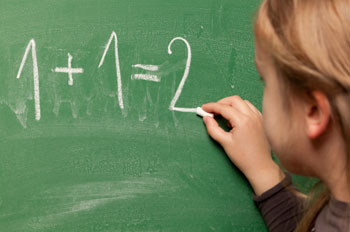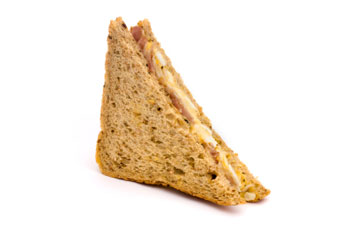Third Grade Geometry Lessons and Teaching Strategies
Third graders identify and compare shapes, calculate perimeter and use multiplication to find the area of a rectangle. Keep reading for an in-depth overview of the third grade geometry curriculum as well as ideas for hands-on activities to teach these concepts.

Approaches for Teaching Third Grade Geometry
Shapes of Polygons
In third grade, students name and describe a variety of 2-dimensional shapes. They then compare the shapes using the number of sides and angles.
One way to introduce the names and attributes of specific shapes is to use books such as Museum Shapes by The (NY) Metropolitan Museum of Art. Children are challenged to find one of ten shapes in several pieces of art from the museum's collections. Although no book will likely cover all of the shapes third graders need to know, another shape book is Icky Bug Shapes by Jerry Pallotta. Even Dr. Seuss contributes to the shape-book fun with The Shape of Me and Other Stuff - he'll have your students noticing the shapes of almost everything.
Kinds and Classifications of Shapes
The 2-dimensional shapes covered in third grade include circles, triangles, squares, rectangles, rhombuses and trapezoids. You may include as many other shapes - such as pentagons and octagons - as you wish. Shapes are categorized into groups where all shapes have the same number of lines and angles, such as parallelograms and quadrilaterals (as seen below).
- Parallelograms have two pairs of parallel sides. For example:
- Square
- Rectangle
- Rhombus
- Quadrilaterals have four sides and four angles. Some examples are:
- All parallelograms
- Trapezoids
Give each student a sheet with the names of all of the shapes they've learned. Go on a 'field trip' to the playground, a park or some other location where the children can go on a scavenger hunt to search for items to match each shape.
Perimeter
To find the perimeter of any shape with angles, simply add the lengths of all its sides. A good book to help practice perimeters is Spaghetti and Meatballs for All! by Marilyn Burns. Alternatively, make up a song such as this one (to the tune of Jingle Bells) to help them remember what a perimeter is:
- Perimeter, perimeter
Goes all around the edge.
Add all of the sides together,
Your answer's right, I pledge!
Area
To find the area of a rectangle, students may cover a given rectangle with unit squares by either coloring in squares on graph paper, or placing unit cubes over the shape. They find the area by counting how many cubes or colored squares there are. The answer is in square units - inches, feet, centimeters or meters.
Once children have found the area of a given rectangle using the unit squares, you can show them that if they count the number of units in a row and then in a column and multiply these two numbers, they will come up with the same answer. Eventually, you may introduce the formula A = l x w, which indicates that you multiply the length of a shape by its width to find the area.
Relating Area to Addition
Finding the area of a 'weird' figure made of rectangles can be fun - just find the area of each rectangle within the shape and add them together for the total area of the figure. Give each student a piece of graph paper and allow them to draw any kind of shape as long as all parts are joined to the whole and there are no curved or diagonal lines. They then divide the shape into rectangles (grouping as many units together as possible for each rectangle, and being sure there is no overlap of rectangles). Find the area of each rectangle, add them together and - voila - they've found the area of the picture. The weirder the picture, the prouder they will be of finding the area.
Relating Area to Fractions
Third graders can divide rectangles into equal parts. They already know from their lessons in fractions that ½ + ½ is a whole. To relate this to area, have a large rectangle in tape on the floor, divided into as many units as there are children in the class. If you have extra children, they can be your helpers. With one child standing in each square in the rectangle, figure how many 'square children' the rectangle is. You or your helpers divide the children into two equal parts, asking for ½ of the area (or 'square children') to step to the north and the other half to the south. Do the same with thirds and fourths.
Other Articles You May Be Interested In
-
Not Your Father's Algebra As 45 States Look to Math Reform

One plus one will always equal two...but just how students are taught math is going to change. Nearly every state in the country has adopted the Common Core Standards; for math, this means new and more in-depth approaches to teaching the subject. Have we seen the last of traditional algebra and geometry classes?
-
The Pythagorean Theorem: Almost As Easy As ABC

One of the most useful and widely used rules in mathematics is the Pythagorean theorem. Your child's mastery of this theorem is critical to success in geometry. One helpful method for understanding and remembering a rule like the Pythagorean theorem is to fully explore its meaning and history.
We Found 7 Tutors You Might Be Interested In
Huntington Learning

- What Huntington Learning offers:
- Online and in-center tutoring
- One on one tutoring
- Every Huntington tutor is certified and trained extensively on the most effective teaching methods
K12

- What K12 offers:
- Online tutoring
- Has a strong and effective partnership with public and private schools
- AdvancED-accredited corporation meeting the highest standards of educational management
Kaplan Kids

- What Kaplan Kids offers:
- Online tutoring
- Customized learning plans
- Real-Time Progress Reports track your child's progress
Kumon

- What Kumon offers:
- In-center tutoring
- Individualized programs for your child
- Helps your child develop the skills and study habits needed to improve their academic performance
Sylvan Learning

- What Sylvan Learning offers:
- Online and in-center tutoring
- Sylvan tutors are certified teachers who provide personalized instruction
- Regular assessment and progress reports
Tutor Doctor

- What Tutor Doctor offers:
- In-Home tutoring
- One on one attention by the tutor
- Develops personlized programs by working with your child's existing homework
TutorVista

- What TutorVista offers:
- Online tutoring
- Student works one-on-one with a professional tutor
- Using the virtual whiteboard workspace to share problems, solutions and explanations